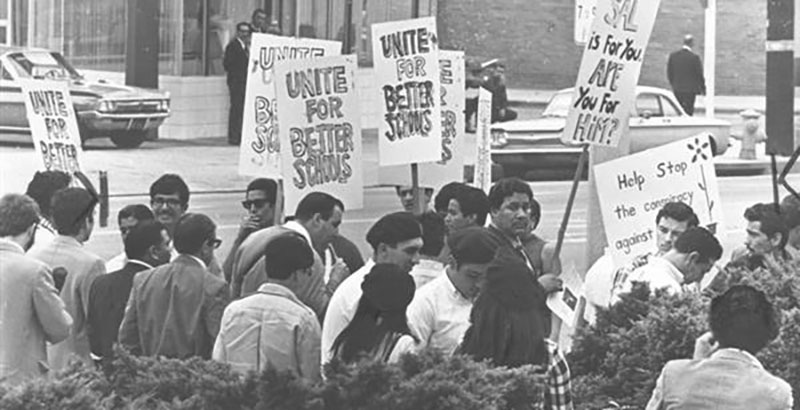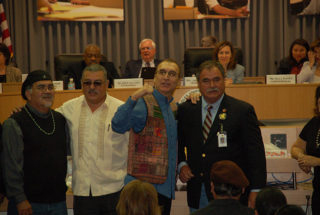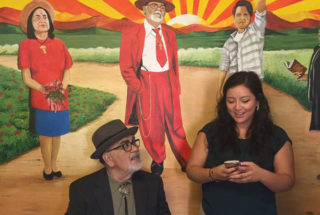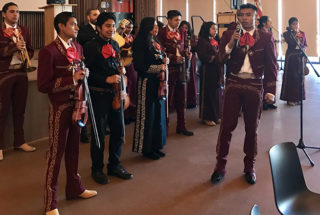50 Years After the Walkouts, Los Angeles Latino Students Are Still Fighting for Educational Equity

This piece was produced in partnership with LA School Report
Before there were Dreamers, thousands of young Latinos marched out of their East Los Angeles classrooms half a century ago for their right to be educated.
“I was never told I was college material or capable of aspiring for something better,” said Bobby Verdugo, one of the leaders of the 1968 Chicano student movement known as “Walkouts or Blowouts.”
“Dreamers are being marginalized today. They are being treated like they don’t belong here, like they are not wanted. That’s how we felt 50 years ago,” Verdugo said.
March 1 marks the 50th anniversary of what has been called the nation’s first major mass protest against racism by Mexican-Americans. More than 15,000 students from Roosevelt, Wilson, Garfield, Lincoln, and Belmont high schools walked out of their classrooms to challenge the inequalities in Los Angeles public schools. Fifty years later, their bold action has reaped educational gains for Latinos, but they haven’t come fast enough, advocates say.
Verdugo went to Lincoln High, but like the majority of his peers, he didn’t graduate. In those days, 60 percent of Chicano or Mexican-American students dropped out of high school. Few who did graduate went on to college. Teachers and administrators didn’t have high expectations for Latino students, said Verdugo, who obtained his high school diploma in 2016, 48 years later.
Latino students in 1968 had no textbooks reflecting their history or their culture. They had to refrain from speaking Spanish at school. Teachers and school leaders didn’t look like them. Classrooms were overcrowded. They had no pathway to college nor the opportunity to take all the classes needed to get there.
Today’s Latino students, who make up three-quarters of LA Unified, have access to all classes required for entrance into the state’s public universities, known as A-G courses. They can study in bilingual programs and take ethnic studies courses that teach about their culture and history. Many more are graduating and attending college. But their academic achievement and college graduation rates still lag their peers’.
Persistent Low Achievement
There’s not a single county in California where a majority of Latino students are proficient in math or English language arts, according to The Majority Report, released last fall by Education Trust—West. Statewide, Latino students’ test scores dropped last year, to only 17 percent proficient in math and 26 percent in English.
In LA Unified last year, Latinos showed almost no growth on state tests and remained below the district’s average. Only 24 percent were proficient in math and 34 percent in English.
“We’re not there yet. There are gaps in opportunity, there are gaps in achievement, in performance, and those have rooted in the institutional racism and classism that our young people fought against back then,” said Mónica García, president of LA Unified’s school board and only the third Latina to serve on the board.
• VIDEO: “The ‘Walkouts’ or ‘Blowouts’ was the first major mass protest against racism by Mexican Americans in the history of the United States.”
García, who calls herself a “proud East LA Chicana,” says her work in education for the past 25 years has been a result of the movement’s demand for access to quality schools. She believes no one is satisfied with the pace of change and that there’s still much work to be done.
“We have seen progress. It has taken too long, but it is happening.”
García said standardized tests are important, but they don’t measure the whole experience of Latino students in their classrooms. “This is not an excuse, we’re not yet satisfied. While we now have the A-G curriculum, we need decentralization in the district so we can better support this student population. Build the curriculum, the program around Latinos.”
She said the fact that California ranks so low in the nation in terms of per-pupil spending is not helping efforts to improve education for the state’s Latino students. In 1968, California was fifth in the nation; now it ranks between 37th and 46th, depending on the measurement.
Nationally, the high school dropout rate reached a record low of 6 percent in 2016, but among Latinos it was 10 percent. In LA Unified, Latinos’ dropout rate last year was 14 percent, and of those who graduated, only 39 percent were college- and career-ready.
Latino students in college continue to be underrepresented at public universities in California, where more than half of high school graduates are Latino. At the University of California system, 1 in 3 is a Latino, but more than 1 in 5 reported not feeling respected on campus, according to The Majority Report.
Across the nation, the number of Latinos graduating from college is slowly increasing. In 2016, 47 percent of Latino high school graduates ages 18 to 24 were enrolled in college, but just 15 percent of Latinos have graduated from college, according to the Pew Research Center. In comparison, about 41 percent of whites completed college.
What’s Been Gained
The leaders of the Walkouts took their demands to LA Unified’s board of education at a special meeting on March 11, 1968. More than 1,400 students were present to hear their pleas refused. Five decades later, however, much of what they fought for has come to fruition.

They wanted new schools and better facilities, without overcrowding. It took nearly 50 years to get there, but just this year, the last of the schools built under a $20 billion school-building program opened.
The students demanded courses that reflected Mexican-American history and culture, bilingual education, and more teachers, counselors, and administrators of Mexican-American heritage.
Students now come to schools where many more adults look like and relate to them. This year in LA Unified, 37 percent of teachers are Latinos, as well as 43 percent of school administrators and 38 percent of district officials. But as a state, California, which has the nation’s largest Latino student population, also has the biggest Latino teacher-student gap, according to a report released last week by the Center for American Progress.
García pointed to the Latinos now leading in LA Unified as well as the investments made to build new schools and modernize old campuses like Roosevelt High School, which is getting $173-million renovation.
García said the Los Angeles school district has gone from a place where students 50 years ago had to fight to demand their culture and identity be treated with dignity, to a district that now supports the Dream Act, supports immigrant families through its “We Are One campaign,” and offers ethnic studies. And that may become a statewide requirement by the 2021-22 school year under a new bill introduced this month: each school district and charter school in California would have to offer “standards-based ethnic studies curriculum” in grades 9-12.
“This district today understands that it serves Mexican-American children, children of immigrants, people from all over the world. We embrace diversity, bilingual education, and we advocate for our children,” GarcÍa said. “We have moved from having Latino students tracked away from college because of the color of their skin or their last name to having a system where every student can be college-ready and career-prepared.”
Verdugo believes education for Latinos has gotten better for the most part. “We have young Latinos who are striving more vigorously for a better life. They see going to college as a real possibility. More Latinos are going and graduating from college, but the numbers are still poor,” said Verdugo, who dedicates his time to empowering Latino youth in East LA.

While the gaps in college graduation and academic achievement persist among Latino students, Verdugo thinks it’s not only the Dreamers — young Latinos fighting to keep the protections under the Deferred Action for Childhood Arrivals program — who feel alienated. He said even second- and third-generation Latinos born in the U.S. still struggle with feeling out of place in high school classrooms and on college campuses. Verdugo himself is a second-generation Mexican-American, born and raised in East Los Angeles.
He sees many similarities with the Dreamers’ resistance movement now.
“We were being put down, we were being dehumanized. … That’s how we felt 50 years ago even though I was born here and my parents were born here.”
The Dreamers “are admirable, they go to college without even knowing if they have a future here. That’s courageous,” he said, remembering the courage of those who took part in the Walkouts. “Yes, we were afraid, we were kids! We could have been hurt or killed. But we were aware that we had to do something and change things for others.”
Allan García, who is a senior this year at Wilson High, said that because of what the students in the Walkouts risked, he has been able to have a very different experience in the classroom compared to 50 years ago. He said he feels included, has access to a college prep curriculum, and feels proud of his legacy as a first-generation Mexican-American and the son of immigrants.
But he wants to defend what Latinos have gained and to continue fighting, such as for improvements in school discipline. “We are still demanding for the school climate bill of rights to be implemented at every school in the district. We are mobilizing in support of SB 607 so the state can pass the law to reduce suspensions and expulsions,” he said.
The bill aims to extend the ban on suspensions and expulsions for “willful defiance,” which disproportionately affect Latinos and other students of color.
Natalie Macías, a 10th-grader at Roosevelt, appreciates being able to express her Mexican heritage at school through music. She is part of the school’s mariachi band, Mariachi Olímpico, which she calls a major part of her life. “I can’t imagine how hard it would have been for students like me to have been forbidden to express their culture or speak Spanish. It would be so hard for me,” she said. She plans to study bioengineering in college.

Roosevelt High School’s Mariachi Olímpico performing on Saturday at one of LA Unified’s events in commemoration of the Walkouts’ 50th anniversary.
“The reason why the ‘68 Walkouts are so important to understand is because of the courage and commitment and political awakening of those young people,” García said. “We see that in our kids today the kids who are fighting for new schools, fighting for access to A-G, fighting for breakfast in the classroom, for wellness centers, for teachers who are competent. The kids fighting for DACA, for citizenship, that is the strength of our community. It’s so important to recognize our young people’s resilience and capacity to learn and lead.”
She added, “We are learning very much from these young people, including our DACAmented teachers. Very much like the Chicanos in ‘68, the Dreamers have been an incredible political movement from Los Angeles to Washington, D.C. The students’ fight has not ended since ‘68.”
Get stories like these delivered straight to your inbox. Sign up for The 74 Newsletter

;)

